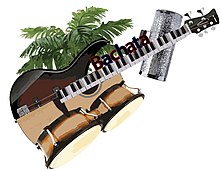| Bachata | |
|---|---|
 Dominican folk bachata musicians - Amargue Bachata Quintet | |
| Cultural origins | Dominican Republic |
| Subgenres | |
| Regional scenes | |
| Other topics | |
| Music of The Dominican Republic | ||
| General topics | ||
|---|---|---|
| Related articles | ||
| Genres | ||
| Media and performance | ||
|
||
| Nationalistic and patriotic songs | ||
|
||
| Regional music | ||
|
||
| This article is part of a series on the |
| Culture of the Dominican Republic |
|---|
| Society |
| Symbols |
| Politics |
| Economy |
|
Dominican Republic portal |
Bachata is a genre of music that originated in the Dominican Republic in the 20th century. It contains elements of European (mainly Spanish music), indigenous Taino and African musical elements, representing the cultural diversity of the Dominican population.[1]
The first recorded compositions of bachata was done by José Manuel Calderón in 1962 ("Borracho de amor") from the Dominican Republic. Bachata originates from bolero and son (and later, from the mid-1980s, merengue). The original term used to name the genre was amargue ("bitterness", "bitter music"), until the mood-neutral term bachata became popular. The form of dance, bachata, also developed with the music.[2]
Bachata arose in the poor and working class areas of the country. During the 1960s and early 1970s, while bachata was known as amargue music, it was seen as music of the lower class by middle-upper-class Dominicans. The genre's popularity rose in the 1980s and early 1990s when the rhythm began to reach the mainstream media. The genre was declared an Intangible Cultural Heritage of humanity by UNESCO.[3]

The genre mixed the pan-Latin American style called bolero with more elements coming from son, and the troubadour singing tradition common in Latin America. During much of its history, bachata music was disregarded by middle-upperclass Dominican society and associated with rural underdevelopment and crime. As recently as the 1980s, bachata was considered too vulgar, crude and musically rustic to be broadcast on television or radio in the Dominican Republic.
In the 1990s, however, bachata's instrumentation changed from nylon string Spanish guitar and maracas of traditional bachata to the electric steel string and guira of modern bachata. Bachata further transformed in the 21st century with the creation of urban bachata styles by bands such as Monchy y Alexandra and Aventura.[4] These new modern styles of bachata became an international phenomenon, and today bachata is one of the most popular styles of Latin music.

- ^ "Origins of Bachata Music". Pimsleur.com. 14 December 2018.
- ^ Pacini Hernandez, Deborah. "Brief history of Bachata", Bachata, A social history of a Dominican popular music, 1995, Temple University Press. Retrieved on December 4, 2008 Archived September 10, 2004, at the Wayback Machine
- ^ "Music and dance of Dominican Bachata".
- ^ Ilich, Tijana. "All About Bachata Boy Band Aventura". LiveAbout. Retrieved 2020-01-07.